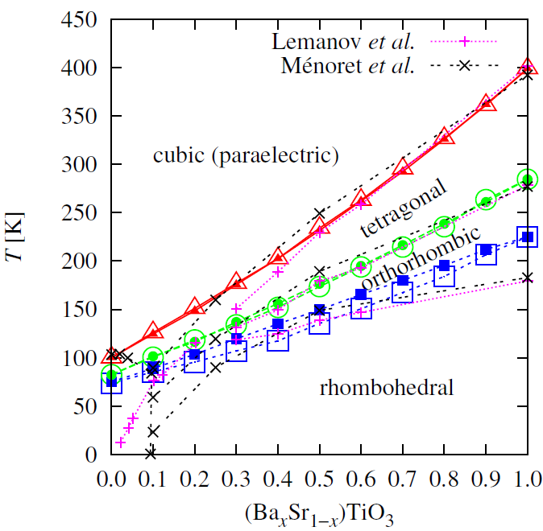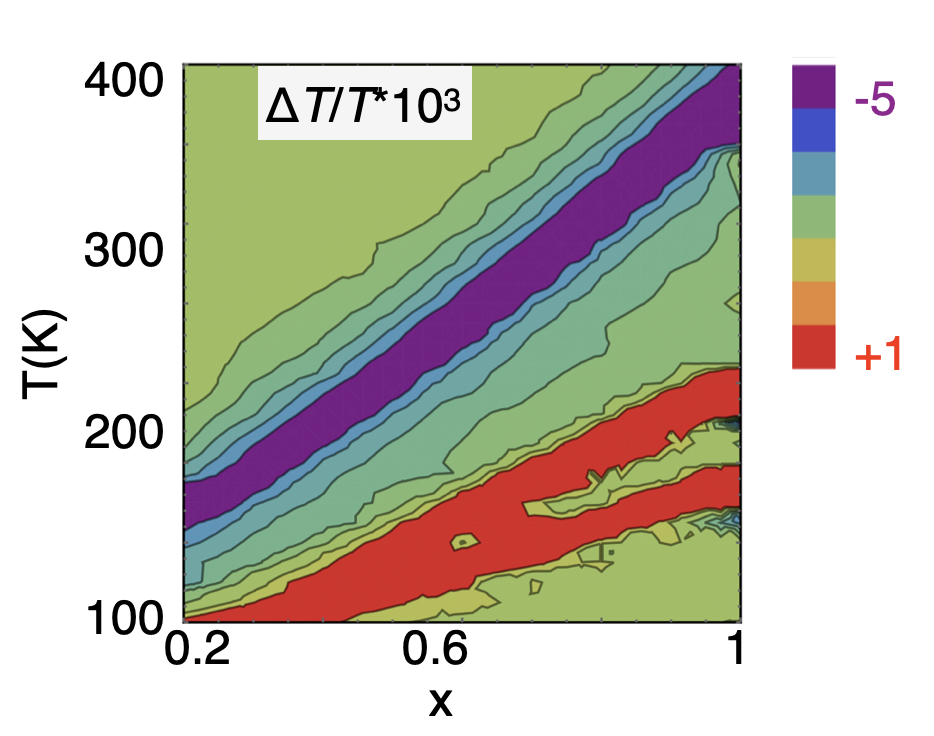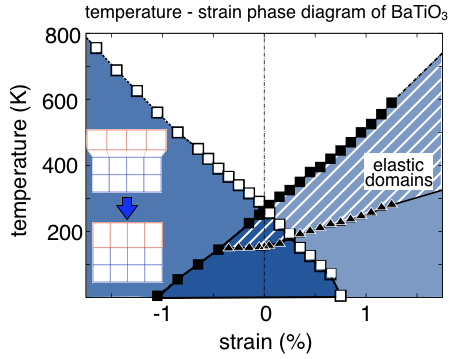Just another WordPress site - Ruhr-Universität Bochum
Research Group Scalebridging Simulation of Functional Composites – Student projects
If you are interested in a student research project in the group Scalebridging Simulation of Functional Composites please contact Prof. Dr. Anna Grünebohm.
Garrity et. al reported that ferroelectrics with LiGaGe structure, see Fig. 1 are not as sensitive to depolarization as compared to standard materials and coined the term hyperferroelectrics for this exciting observation [1]. These materials are particularly interesting for minitarization of ferroelectrics devices as they may show a ferroelectric instability in low dimensions. As so far only a few systematic studies exist, we will investigate the coupling between electronic and atomic structure for the prototypical hyperferroelectric material, NaZnSb via density functional theory and density functional perturbation theory.
Contact: Prof. Dr. Anna Grünebohm or Susanne Kunzman
![Figure 1: Crystal structure of NaZnSb (adapted from [2])](https://www.icams.de/wp-content/uploads/2022/12/NaZnSb3.png)
- Run DFT/Density Functional Pertubation Theory (DFPT) simulations using the abinit package
- Write python scripts
- Process and analyze data
- Running DFT/DFPT simulations in abinit
- Phonon calculations
- Python for data analysis
- Physics of ferroelectrics
- [1] Kevin F. Garrity, Karin M. Rabe, and David Vanderbilt. Hyperferro- electrics: Proper ferroelectrics with persistent polarization. Phys. Rev. Lett., 112:127601, Mar 2014.
- [2] Anubhav Jain, Shyue Ping Ong, Geoffroy Hautier, Wei Chen, William Davidson Richards, Stephen Dacek, Shreyas Cholia, Dan Gunter, David Skinner, Gerbrand Ceder, and Kristin A. Persson. Commentary: The materials project: A materials genome approach to accelerating materials innovation. APL Materials, 1(1):011002, 2013.
The functional properties of ferroelectrics are governed by domain walls and their mobility. Recent studies reveal exotic properties like drastic domain wall acceleration and the effect of transient negative capacitance under an ultrafast field application as an intrinsic property of ferroelectrics. In this work, we will study how domain wall mobility is modified by the presence of an open interface and finite thickness of the ferroelectric film. We will use first-principal-based molecular dynamic simulations to investigate the impact of film thickness on domain wall dynamics. To do so, a microscopic analysis of local dipoles dynamics will be done, including statistical data analysis and its visualization. You will be supported in running molecular dynamics simulations and Python programming. During the project, you will gain knowledge about ferroelectric and statistical data analysis. See the literature to get insight into the topic [1] and investigate various domain walls using first-principle-based molecular dynamics [2].
Contact: Prof. Dr. Anna Grünebohm

- [1] Ruben Khachaturyan, Aris Dimou, Anna Grünebohm, Domain wall acceleration by ultrafast field ramping and non-equilibrium dipoles dynamics: an ab initio based molecular dynamics study, arXiv:2109.10062
- [2] A. Grünebohm, M. Marathe, Impact of domains on the orthorhombic-tetragonal transition of BaTiO3: An ab initio study, Phys. Rev. B 114417, 2020
Ferroelectric perovskites possess versatile functional properties and are used in a variety of modern electronic devices. In particular, the piezoelectric response of lead-free materials is of great interest in the field of sensors and energy harvesting [1]. Important challenges in this field are: How to enhance the mechanical strain response induced by the electric field and how to improve its temperature stability. This project focuses on the piezoelectric properties of solid solutions of BaTiO 3 –SrTiO 3 , where exceptionally large responses are possible at the three phase transitions (tetragonal, orthorhombic and rhombohedral phases) whose temperature can be adjusted by the compositions (see Fig. 1a). Your task is to calculate the piezoelectric coefficient d 33 for various temperatures and compositions using the code Feram (http://loto.sourceforge.net/feram), and finally construct a contour plot (similar to Fig. 1b but for piezoelectric response). This plot allows to predict optimal Sr-concentrations for applications
Contact: Prof. Dr. Anna Grünebohm


- [1] M. Acosta, N. Novak, V. Rojas, S. Patel, R. Vaish, J. Koruza, G. A. Rossetti, and J. Rödel. BaTiO 3 -based piezoelectrics: Fundamentals, current status, and perspectives. Appl. Phys. Rev., (4):041305, 2017.
- [2] Takeshi Nishimatsu, Anna Grünebohm, Umesh V. Waghmare, and Momoji Kubo. Molecular dynamics simulations of chemically disordered ferroelectric (Ba,Sr)TiO 3 with a semi-empirical effective hamiltonian. J. Phys. Soc. Jpn., 85(11):114714, 2016.
- [3] Anna Grünebohm and Takeshi Nishimatsu. Optimizing the electrocaloric effect by ab initio based simulations: the benefits of substitution. International Conference on Caloric Cooling, Proceedings of Thermag, VIII(5):pap. 0006, 2018.
In this project we investigate the impact of interface strain on the functional responses of ferroelectric composites.
Ferroelectric perovskites are widely used in applications and are promising for energy harvesting as well as for future efficient solid-state cooling devices. All applications share the following demands on materials design: Replace toxic Pb and increase efficiency of the functional responses in a broad and suitable operation range. In this quest, ferroelectric composites came into focus as they can be optimized by the choice of different constituents and their morphologies.
Recently we have shown how one may optimize the electrocaloric response of BaTiO3 films by biaxial strain in the (001)-plane. Thereby the domain structure of the film plays a crucial role. The task of this project is to extend this study to different crystallographic directions and solid solutions of (Ba,Sr)TiO3. We will explore the temperature-strain phase diagrams of and the stability of specific elastic domain structures. For this purpose we will perform coarse-grained molecular dynamics simulations employing the feram code.
Contact: Prof. Dr. Anna Grünebohm

In this project you will use molecular dynamic (MD) simulation to simulation domain wall (DW) propagation in ferroelectric crystals under an external electric field. Analysis of local polarizations and its collective behavior will be done using Python.
Contact: Prof. Dr. Anna Grünebohm or Sheng-Han Teng.

- Run MD simulation
- Write python scripts
- Process and analyze the data
- Running MD simulations
- Python for data analysis
- Physics of ferroelectrics
Despite of critical importance of phase transitions (PTs) in ferroelectrics, the process of PT remain unclear hitherto. Recent studies demonstrated PT with coexisting paraelectric and ferroelectric phases. In the framework of this project we will shed some light on the question of paraelectric-ferroelectric PT using molecular dynamic simulations. Python will be used as a main tool for output data analysis and results visualization.
Contact: Prof. Dr. Anna Grünebohm

- Run MD simulation
- Write python scripts
- Process and analyze the data
- Running MD simulations
- Python for data analysis
- Phase transition
- Physics of ferroelectrics
